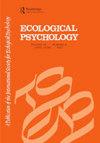Meta-Invariant Structure in Stimulus Arrays: A Response to Mace's Zetetic Challenge to Ecological Perceptual Researchers
IF 1.7
3区 心理学
Q3 PSYCHOLOGY, EXPERIMENTAL
引用次数: 5
Abstract
ABSTRACT Ecological perception, per James Gibson's theory, avows that perception depends on informative structure in stimulus arrays, where information is defined as stimulus array invariants. Gibson, however, was somewhat vague about the nature of such structure. Consequently, ecological perceptual research—even acknowledging some remarkable successes—has generally been ad hoc: Lacking principled heuristics, researchers examine array structure, which, by some means, they have come to discover as (or believe to be) informative. Here, I propose a series of heuristic principles potentially useful for the discovery of informative structure in stimulus arrays, with examples to suggest how those principles might apply. The major benefit of principled search for stimulus array invariants is more efficient elaboration of their function in perception. While admittedly preliminary, the principles outlined may both guide perceptual investigations and prompt additional consideration of how to approach the search for stimulus array invariants.刺激阵列中的元不变结构:对梅斯对生态感知研究者的Zetetic挑战的回应
摘要根据James Gibson的理论,生态感知依赖于刺激阵列中的信息结构,其中信息被定义为刺激阵列不变量。然而,吉布森对这种结构的性质有些含糊。因此,生态感知研究——甚至承认了一些显著的成功——通常是临时性的:由于缺乏原则性的启发式方法,研究人员会检查阵列结构,通过某种方式,他们发现(或相信)阵列结构是有信息的。在这里,我提出了一系列启发式原则,这些原则可能有助于发现刺激阵列中的信息结构,并举例说明这些原则可能如何应用。原则性搜索刺激数组不变量的主要好处是更有效地阐述它们在感知中的功能。虽然公认是初步的,但所概述的原则既可以指导感知研究,也可以促使人们进一步考虑如何搜索刺激数组不变量。
本文章由计算机程序翻译,如有差异,请以英文原文为准。
求助全文
约1分钟内获得全文
求助全文
来源期刊

Ecological Psychology
PSYCHOLOGY, EXPERIMENTAL-
CiteScore
3.30
自引率
10.50%
发文量
8
期刊介绍:
This unique journal publishes original articles that contribute to the understanding of psychological and behavioral processes as they occur within the ecological constraints of animal-environment systems. It focuses on problems of perception, action, cognition, communication, learning, development, and evolution in all species, to the extent that those problems derive from a consideration of whole animal-environment systems, rather than animals or their environments in isolation from each other. Significant contributions may come from such diverse fields as human experimental psychology, developmental/social psychology, animal behavior, human factors, fine arts, communication, computer science, philosophy, physical education and therapy, speech and hearing, and vision research.
 求助内容:
求助内容: 应助结果提醒方式:
应助结果提醒方式:


